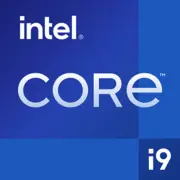Intel Core i9-9900X

Intel Core i9-9900X: Review and Relevance in 2025
April 2025
Key Features: Architecture and Performance
The Intel Core i9-9900X processor, released in the late 2020s, remains popular among enthusiasts due to its unique combination of characteristics.
- Architecture and Process: Based on the Skylake-X microarchitecture and built on a 14nm process. Despite being outdated by 2025's standards (new AMD and Intel chips use 5–7nm technology), it shows stable performance due to optimization.
- Cores and Frequencies: 10 cores (20 threads) with a base frequency of 3.5 GHz and turbo mode up to 4.4 GHz. This is an excellent figure for multi-threaded tasks, especially when using software optimized for Hyper-Threading.
- Cache and TDP: 20 MB of L3 cache and a TDP of 165W. The high thermal output requires effective cooling.
- Performance: In the Geekbench 6 benchmark (Single Core: 1455; Multi Core: 10273), it lags behind modern counterparts in single-threaded workloads but remains competitive in rendering and encoding.
Key Features:
- Support for AVX-512 to accelerate computations in scientific and engineering applications.
- Unlocked multiplier for overclocking (although potential is limited due to the 14nm process).
Compatible Motherboards
The i9-9900X requires an LGA 2066 platform and Intel X299 chipset. In 2025, such motherboards are hard to find in retail—average prices for remaining stock range from $200 to $300.
Selection Recommendations:
- ASUS ROG Rampage VI Extreme: A reliable board with a powerful power system (16 phases), supporting PCIe 3.0 and 4-channel DDR4.
- MSI X299 PRO: A budget option ($220) with basic functionality for non-overclocked operation.
Features:
- Lack of PCIe 5.0 and DDR5 — the main drawback of the platform.
- Check for M.2 slots for NVMe if you plan to use fast SSDs.
Supported Memory
The processor only works with DDR4:
- Speeds: Officially up to 2666 MHz, but many boards support overclocking to 3600 MHz.
- Modes: 4-channel configuration for maximum bandwidth (relevant for rendering and large data tasks).
Example Configuration:
- 64 GB DDR4-3200 (4x16 GB) — optimal for workstations.
Power Supply: Recommendations
With a TDP of 165W and demand for stable power:
- Minimum: 650W (for a system with an RTX 4070 level GPU).
- Recommended Option: 750–850W (e.g., Corsair RM850x or Seasonic Focus GX-750).
Important: When overclocking or using a high-end GPU (RTX 4090), choose power supplies with a power reserve and an 80+ Gold certification.
Pros and Cons
Strengths:
1. High multi-threaded performance for rendering, encoding, and virtualization.
2. Affordable pricing ($400–450 for new units) compared to Ryzen 9 7900X ($550).
3. Compatibility with DDR4, which lowers the upgrade cost for older systems.
Weaknesses:
1. High power consumption and heating (requires a liquid cooling system or a powerful cooler).
2. No support for PCIe 5.0 and DDR5.
3. Outdated manufacturing process—losing energy efficiency to new chips.
Usage Scenarios
- Work Tasks: Ideal for 3D rendering (Blender, Cinema 4D), 4K video editing (Premiere Pro), and code compilation.
- Gaming: In Full HD/1440p with an RTX 4080 level GPU, it achieves 100+ FPS in most titles, but in CPU-dependent games (e.g., Civilization VI), it lags behind modern 13th generation Core i5 processors.
- Multimedia: Streams 4K without lag thanks to 20 threads.
Comparison with Competitors
Main competitors in 2025:
1. AMD Ryzen 9 7900X ($550):
- 12 cores/24 threads, 5nm, Geekbench 6 Multi: 12500.
- Pros: PCIe 5.0, DDR5, higher efficiency.
- Cons: More expensive.
2. Intel Core i7-14700K ($420):
- 16 cores (8P + 8E), 7nm, Geekbench 6 Multi: 11000.
- Pros: Better single-threaded performance (+15% compared to i9-9900X).
Conclusion: The i9-9900X is only advantageous if you currently have a compatible motherboard or a limited budget.
Practical Assembly Tips
1. Cooling: Use a 280–360mm liquid cooling system (e.g., NZXT Kraken X63) or a top-tier air cooler (Noctua NH-D15).
2. Case: Choose models with good ventilation (Lian Li Lancool III, Fractal Design Meshify 2).
3. BIOS: Update the motherboard firmware for compatibility with new SSDs and peripherals.
4. Memory: 4-channel mode is essential to unlock the CPU's potential.
Final Conclusion: Who is the i9-9900X Suitable For?
This processor should be considered in two cases:
1. Upgrading an Old System: If you already have an X299 board and DDR4, the i9-9900X will provide a performance boost without replacing the platform.
2. Budget Workstation: It is still relevant for rendering and computations, especially at a price of $400.
Not Suitable For:
- Gamers focused on future projects with PCIe 5.0 support.
- Users for whom energy efficiency is critical.
In 2025, the i9-9900X is a niche solution, but with proper use, it can form the foundation of a powerful and reliable system.
Basic
CPU Specifications
Memory Specifications
GPU Specifications
Miscellaneous
Benchmarks
Compared to Other CPU
Share in social media
Or Link To Us
<a href="https://cputronic.com/cpu/intel-core-i9-9900x" target="_blank">Intel Core i9-9900X</a>